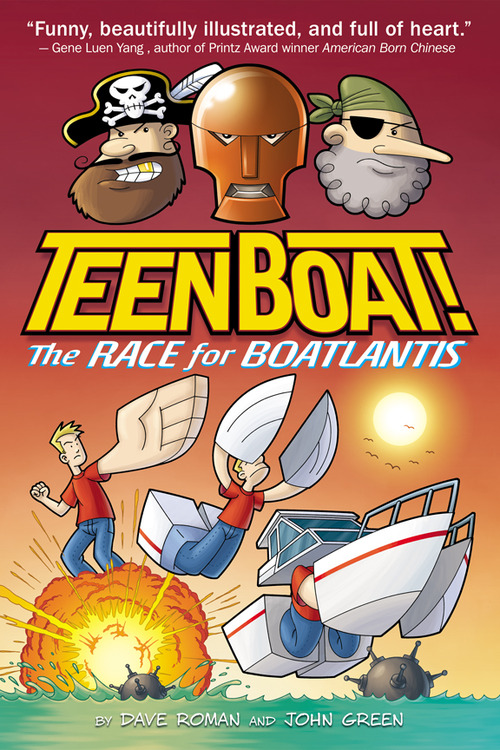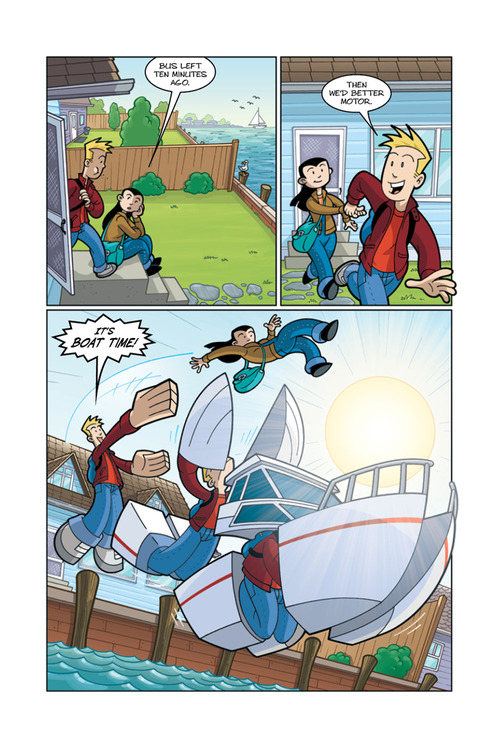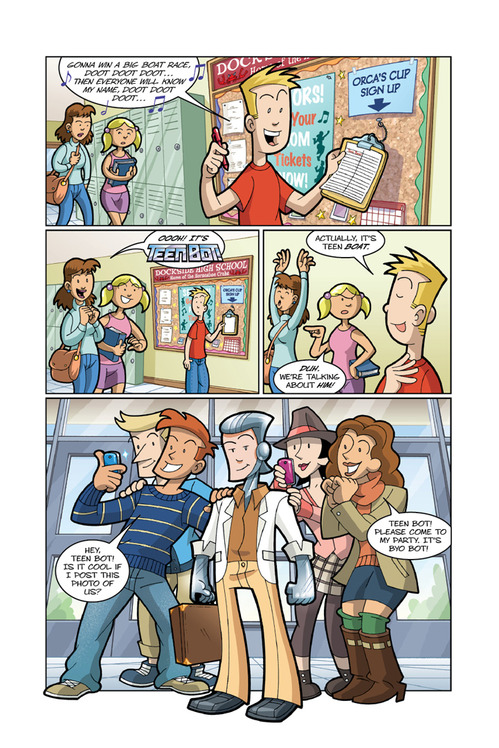Plenty of comics deal with teen angst, especially the kind that comes from radioactive spider-bites, mutant puberty or discovering that your parents are secretly super-villains. Only one comic, however, can boldly proclaim to capture the angst of being a teen and the thrill of being a boat.
Dave Roman and John Green’s Teen Boat!, published by Clarion Books, follows the titular half-adolescent, half-vessel as he navigates typical teen drama, with the added possibility that he’ll get water in his ear and instantly transform into a yacht. While the premise seems like a one-off joke (and pretty much started that way), Roman and Green have expanded Teen Boat’s story into a second volume, Teen Boat! The Race to Boatlantis, a pun-a-page romp that introduces new dimensions to the book’s nautical mythology.
The print edition hits shelves in September, but the longtime creative duo has been serializing pages at teenboatcomics.com. In advance of the final order cutoff for comic retailers, Paste has an exclusive first look at the new trailer, animated by Denver Jackson, which gives a taste of Teen Boat’s seafaring adventures to come. (Without spoiling it, the trailer is an homage to a beloved eighties property—as is often true with Roman and Green.)
Paste also chatted with the two landlubbers behind the book about Teen Boat’s creation, navigating adult content in books for young readers, and branching out into webcomics.![]()
Paste: It’s been a few years since the first print volume of Teen Boat hit shelves. Can you give new readers a brief summary of how you ended up working together on the story of a young person who is also a nautical vehicle?
John Green: We’ve known each other for 20 years. We met when Dave was just finishing high school and I was starting college, and we quickly started doing comics. We started by doing this series Quicken Forbidden, which was a fantasy-type series, and after doing it for a few years and exhibiting at comic shows like San Diego Comic-Con and Small Press Expo, we started talking about doing something different, something funny. We lived in New York and Small Press Expo is a convention down in Maryland. It’d be like a five-hour bus trip, and one time we just started talking about old cartoons.
I remembered a show that Dave had never heard of called Turbo-Teen. I described it to him and he said, “This sounds amazing! This sounds like an awesome idea, a kid that turns into a car!” And it was a terrible cartoon, it wasn’t very good at all. He said, “No, the idea is good, it’s the execution that’s bad.” And I said, “I guess you have a point there. The idea could have been sillier. He could have been a teen who turned into a boat.” And David’s basic response was like, no, that’s a good idea too! And I said, “But what would it be about, the angst of being a teen and the thrill of being a boat?”
And right there, on that bus, we knew we needed to make this comic. [Laughs]
David Roman: To be fair, it was more of a dare in a way. We knew it was a really ridiculous idea. Did we have the follow-up to actually make it?

Teen Boat! The Race for Atlantis Cover by John Green
Paste: In the first volume of Teen Boat, TB is really the strangest thing around (minus the talking gondola), but this volume opens the floodgates to a lot more of the mythology behind the series. Was it a struggle to keep things relatable and maintain “the angst of being a teen” while expanding the fantasy elements?
Roman: I always imagined that the world that Teen Boat lives in was a weird world, but when you’re in high school, you really think that your world is the whole world. You don’t realize that there’s all this other weird stuff out there, that everybody sort of feels the way you do. You’re so self-centered and in your own headspace that you don’t realize it. So I feel like this book, because it’s about TB graduating and exploring the world outside of high school, it gave us the chance to blow the doors off and go really crazy and show how much other weird stuff actually is in this world. TB is just a small part of it. As weird as we get with the ideas, they always feel grounded to the emotional core of what it means to be a teenager, sometimes intentionally, sometimes unconsciously. [Laughs]
Paste: One thing that surprised me the first time I read Teen Boat is that it’s not afraid to get a little edgy with jokes about weed and sex, even though it never—forgive the pun—goes overboard. How much do you think about age-appropriateness when you’re writing?
Roman: The honest answer is that it’s been an evolution. When John and I first started Teen Boat as a mini-comic, we really didn’t have to worry about stuff like that at all. We could just basically tell the story that came out of our heads. John and I are both kids of the eighties, and growing up watching a lot of John Hughes movies, and even kids movies like Goonies—if you watch them today, they’re a lot edgier. You’ve got kids cursing, you’ve got all sorts of sexual jokes. I feel like the movies of the eighties were not afraid to show how kids really are, whereas now everyone’s really paranoid that you can’t let people even know that this stuff exists.
The idea of a kid going to a party where there’s drinking, that’s just real, that’s just something that’s 100% going to be in their life at some point, so to deny that it exists just seems disingenuous in a lot of ways. But we learned after we put that first book out that a lot of parents don’t want their kids to know that this stuff exists. [Laughs] It raised some eyebrows about who exactly the book was for. The book definitely says “teen” right on the cover but I think people assumed we were just joking and that it was for younger kids.
Green: And “teen” is a bit…in reality that’s almost ten years. It can run from a 13-year-old to a 19-year-old but there’s a world of difference between people of those ages. When we were doing the original mini-comic, even though it was about a high school teenager, we were kind of doing them as a wink and a nod to an after-school special. If you were beyond your teenage years, if you were in your early twenties, you would read this and laugh at it. Like these are the angsty emotional issues and choices that kids had to make. They were horrific to go through but now that you’re older you can laugh at it.
When it got collected by the publisher, there were two jokes, one was a dialogue joke and the other was a visual joke. Our editors said to us, “These jokes here are a little too suggestive or edgy. If you want to keep them, that’s fine, but we’ll have to say the book is for 15 and up, not 11 and up. You’ll increase your audience more if you just redraw these two jokes.” And we were like, I guess it’s fine, the mini-comics were out there. We came up with alternate jokes. We didn’t feel like we were being censored. We did the book not thinking about the audience and now it was like, Maybe we should think of the audience. And there were still things people objected to! [Laughs]
Roman: We were kind of surprised when the book came out and some people were upset about stuff. We thought, Oh, we took all the bad stuff out, but there’s a wide margin for what people think is inappropriate. But I think with the second book, we’ve made more of a conscious effort to avoid going too far in that direction in advance. I always thought that as long as your main character is not endorsing these things, you’re clear. I didn’t realize that just acknowledging them might be a problem.
Green: And they get in trouble, too. They get in trouble for taking a boat out and gambling. Any bad behavior, we’re making a commentary on. They either get in trouble or get looked down on for it. But some parents don’t see that, they just see that it’s in the book, regardless of us saying, This is bad, kids shouldn’t do it.
Roman: Graphic novels have an extra special thing that happens because it’s visual. People can jump to it immediately and it can be taken out of context. I think that’s why a lot of graphic novels get banned for content that a lot of YA books have no problems with, because you’d actually have to read [the YA novels]. [Laughs]

Teen Boat! The Race For Boatlantis Art by John Green
Paste: Part of Teen Boat’s appeal is his complete cluelessness about his long-suffering best gal pal Joey’s feelings. Is that goofy lack of awareness drawing on your own teen years?
Roman: To a certain extent. As I grew up, I would reconnect with people I went to school with and find out after the fact that girls I thought were really attractive, that I would never have a chance with, would come out and say, “I totally liked you, but you weren’t interested in me!” [Laughs] It goes back to the idea that teens are in their own world and might not see something immediately in front of them, like their best friend being in love with him, or his best friend having secret powers as well, which is a running joke in the series. Teen Boat thinks he’s the only one but his best friend has her own secrets and he’s just too caught up in his own nonsense to notice.
Like so many things in Teen Boat, we’re pulling from years and years of digesting pop culture. The trope of the girl next door, which was so prevalent in teen movies: the girl who seems like a Plain Jane, but at the prom or the end of the story, you realize she’s amazing, and why didn’t I notice all along?
Paste: Teen Boat is littered with seafaring wordplays and pop culture callouts. Do you have any favorite cameos or puns that you’ve snuck in?
Roman: I don’t want to spoil too much in the second one, but there’s this underwater world that’s full of boat tributes to pop culture. John, were you the one that came up with the theme of the prom being “Sea’s All That”?
Green: I think you came up with that! [Laughs] And of course the logo is stylized like the Enchantment Under the Sea dance from Back to the Future. There’s a Star Trek 4 reference to transparent aluminum, which is just a throwaway line.
Roman: Some of it’s just jokes between John and me that we’re not even sure will translate in the final product. When we were designing Teen Boat’s rival, we said he was like James Spader from Pretty in Pink, totally eighties James Spader, a preppy, snobby eighties kid.
Green: Yeah, with the white blazer and the rolled-up sleeves.
Roman: But it’s also a reference to the SilverHawks. So it’s always a couple of things combined, mixed into the smoothie.

Teen Boat! The Race For Boatlantis Art by John Green
Paste: You’re both cartoonists even though you’ve split duties along writer/artist lines for this series. How has your collaboration evolved over the years? Dave, how much do you sketch out and John, how involved are you in plotting and scripting?
Roman: As we first started, I did a little bit more sketching as we were trying to figure things out and build the world of Teen Boat. Even just the conceit of how this kid is going to transform into a boat seemed like a logistical nightmare. As we went on, very quickly, it seemed like John just figured it out. There was less needed on my part to figure it out visually. John contributes a lot to the story because we bang out so much of the book before it even starts. A lot of the book came out of conventions and bus rides and stuff, so it was a lot of back and forth as far as the story goes.
Green: On the first book, since we were doing it as a mini-comic, we were just doing it a chapter at a time. Each time we went to a convention, we’d sell them for fifty cents each. Originally, Dave would do thumbnails. He’d write his script and he’d just roughly sketch out the panels so he’d know it’d all fit in eight pages, and he’d give it to me and I’d alter it as necessary. He gave me a very easy guide to follow. Sometimes he’d say, “And then Teen Boat transforms into a boat,” and I’d be like, “Dave, I want you to do a sketch of what you think that looks like.” [Laughs] And he’d say it should look like how the Transformers transform in the comic, where you see a couple panels of them in stages. He drew a little version and I’d base my version on that. At the same time, I’d come up with a lot of nautical-based puns. Dave would write stuff very sincerely a lot of the time, and I’d come up with something really silly for someone to say. Or when I took a trip to Venice, I told Dave, “Hey, write a strip where Teen Boat goes to Venice so I can write off my trip as a business expense.” [Laughs] And that’s when Dave came up with the whole gondola storyline.
But for the second book, we had a lot less time to try to put it together. We started right on it after the first book came out. We got together and we hashed out the story. We had a couple of sessions where we plotted everything that was going to happen and Dave went away for three months and came back with a full script, just text, and I had to thumbnail the entire book from beginning to end so we could send those things to our editor to make sure there weren’t any huge story problems. The first one was more organic, in terms of how do we separate “Dave drew this” and “John wrote that” and the other way around, and the second book was a little more traditional. We still worked on it simultaneously, but Dave wrote the text and I drew the whole thing.
Roman: And that was a huge part because we had an editor who needed to read the whole thing, whereas in the past, I could give John things in stages and John could figure it out as we went with the first book, but the second book, because we were working with the publisher, we had to make sure all the pieces were in place, which meant a much more robust script.

Teen Boat! The Race For Boatlantis Art by John Green
Paste: You’ve been serializing The Race for Boatlantis online for free since the beginning of May. What kind of response have you seen from readers?
Roman: It’s hard to tell. I feel like it’s still building. We’re still figuring it all out. There aren’t a lot of kids reading webcomics, so we’re still trying to get it out there and see what happens. More people get involved with it as the story gets further in. I think it’s worth it. It’s a great way of letting people taste-test your book. There are so many books out there these days and people don’t have a lot of money. Getting a sense of what a book is really like and developing a relationship with it is really important. I think webcomics provide a great opportunity for people to do it on their own terms instead of sneaking and trying to read the whole thing in the store. [Laughs]
Green: Teen Boat 2 wasn’t planned to be a webcomic, it was planned to be a book. But a lot of webcomics, even ones telling a larger, serialized story, the creators know they’re going to release a page a day or a page every other day, and they create it specifically so that each page will be a significant thing for the reader to digest. A page will have some sort of beginning or ending, or a punchline, or at least something that makes us feel like, “Oh, I visit this webcomic every other day, and each time I get satisfied by that one page I read.”
Tean Boat, since it wasn’t really structured to be a webcomic, you definitely have to wait until there are a bunch of pages and then read them in a chunk, which is a little different than most webcomics. The goal is that people will get to read a bunch of it and decide whether or not they like it before coming across it in a bookstore.
Paste: Without spoiling anything, this volume nicely concludes Teen Boat’s voyage. What’s next for the two of you—and Teen Boat—once this volume arrives at the docks?
Roman: In my perfect world, Teen Boat would be allowed to grow up. We could do stories about Teen Boat going into adulthood, but publishers usually have their target demographic and don’t go from kids into adult. So we don’t know. Maybe this will be the final one…
Green: Maybe we’ll do a prequel about Teen Boat when he first turns 13.
Roman: We have a lot of people who really do say that this book should be even younger and be sort of like a Tween Boat. We’ll see. [Laughs]